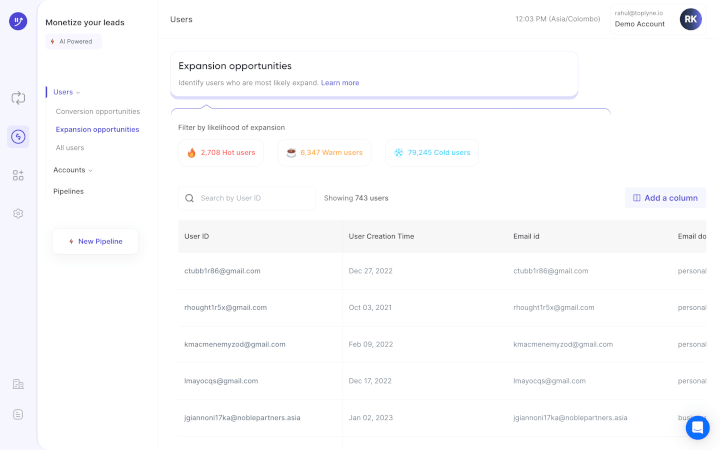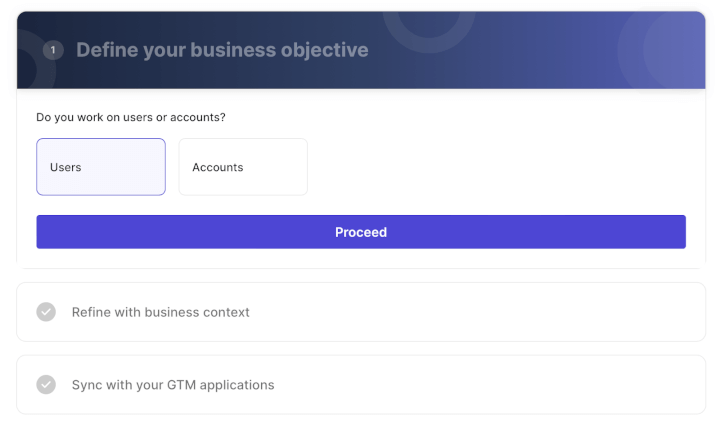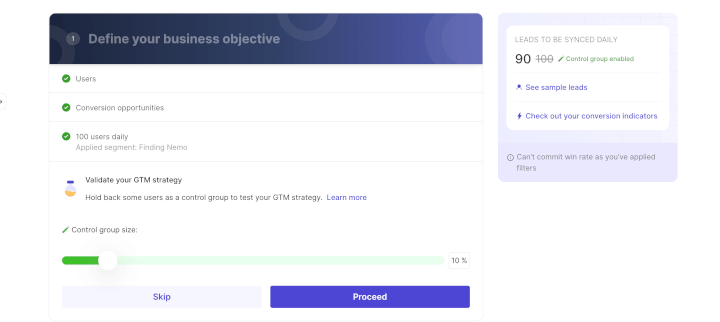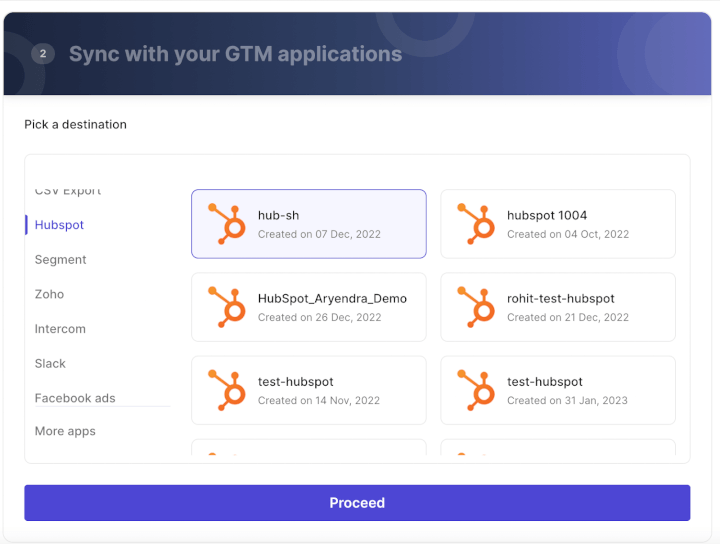Marketing Qualified Account (Pros, Cons + Alternatives)

When accounts need a hero, they may not always know where to look.
That’s why you must show them your software solution can swoop in and save the day! 🦸

Accounts are a collection of leads from the same company. For example, if you have three leads from the same company (say, the CEO, the COO, and a manager), they all belong to the same account.
When a specific account has engaged enough with your marketing efforts, they become a marketing qualified account (MQA).
Accounts, assemble!
In this article, we explore what an MQA is, how they differ from a marketing qualified lead, and how to spot MQAs.
We also cover their pros and cons, a perfect alternative to MQAs, and a superpowered tool to help you identify a qualified account fast.
Let’s get started!
What Is a Marketing Qualified Account (MQA)?
An MQA is a group of leads with the potential to be paying customers.
While they aren’t guaranteed to become sales qualified, their engagement with your marketing effort indicates interest in your product.
If the targeted account engages with your marketing resources enough, you can hand them off to the sales team (more on that later). Then they can officially become a sales qualified lead!
You may be thinking… MQA sounds similar to marketing qualified lead (MQL)...

If you’re getting déjà vu, we’ll explain.
Marketing Qualified Accounts Vs. Marketing Qualified Leads: How They Differ
MQLs and MQAs share three key qualities:
- You assess their engagement with your marketing effort.
- You must nurture them into becoming a product qualified lead (PQL).
- Your end goal is pushing them toward a sale.
So what sets them apart?
Put simply, a qualified lead is an individual.
A qualified account is a group of leads from a company (or the company as a whole).
A B2B marketing approach acquires MQLs via lead and demand generation.
Demand generation involves generating awareness for your product or service via content marketing tactics, social media channels, videos, and more. Lead generation uses these same marketing tactics to convert a marketing qualified lead into a sales qualified lead.
Generating high-value MQLs is where companies run into trouble.
For this reason, some prefer to focus on MQAs, also known as an account based marketing (ABM) approach.
An ABM strategy prioritizes high value accounts that meet their ideal customer profile (ICP) over generating leads that may or may not be worthwhile.
To determine an account’s value, you can monitor ABM metrics like customer lifetime value (CLTV). CLTV measures the total amount of money you can expect a customer to spend throughout the entire business relationship.
Additionally, you can track and analyze demographic and firmographic data to spot individuals within a chosen organization who greatly influence purchase decisions.
Once you’ve spotted your ideal customer, you can personalize inbound marketing campaigns to meet the needs of a targeted account instead of relying purely on marketing automation.
With this ABM strategy, you can create valuable content marketing material, build strong relationships with key decision-makers, and increase the chance of turning them into a sales qualified lead!
Since you’re also focusing on fewer leads, there’s a good chance MQAs may help you reduce customer acquisition costs more than MQLs.
Next, we’ll show you how to detect which accounts are marketing qualified.
How to Identify Marketing Qualified Accounts
So how do you know when an account officially transforms from:

Here are a few examples of accounts you can consider marketing qualified:
- Two different key stakeholders access a particular demo
- A director-level contact requests a meeting
- Three key stakeholders engage with your content marketing materials for 30 minutes or more over a month
Still unsure?
Let’s explore how to develop your MQA criteria in two steps.
1. Measure Engagement
Your demand generation efforts have paid off, and your ABM campaign has caught a prospect’s attention. That’s wonderful!
But they should be willing to go further.

That means you must see which accounts are the most interested in your product or services.
Digital marketing data can help you gauge interest based on actions like:
- Subscribing to newsletters
- Downloading whitepapers
- Regular site visits
- Clicking on ads
- Contacting your sales team
- Liking or responding to social media posts
Psst… Toplyne analyzes in-app actions with product usage data to help you segment leads with real buying intent!
2. Segment Your Accounts
Segmenting means you can invest in nurturing high value accounts instead of wasting time on ones unlikely to be your ideal customer.
With intent data, you can rank (or segment) accounts.
We’ve already mentioned what actions you can measure from digital marketing, but you can also use firmographic data like:
- Industry type
- Buying decision power
- Company size
Then, assign points to the attributes or actions that are most valuable to your B2B company. Now you can see which prospects are qualified!
But is digging into all this data worth the effort, and most importantly, why should you focus on MQAs in the first place?
Let’s dive in!
Benefits of Focusing on Marketing Qualified Accounts
Concentrating on MQAs can power up your ABM campaign efforts in several ways. For example, you can:
1. Appeal to Bigger Teams
Accounts are usually made of 10 stakeholders or more, each with different needs and levels of importance.
As such, sales reps and marketers rarely engage with a target account one-on-one.
So how do you win this battle?
Prepare your sales and marketing teams to appeal to whole accounts rather than just one lead by creating a relationship map — a tool that identifies a specific account member’s role, function, and needs.
Then your ABM marketers can catch potential opportunities like…

Not only does shifting to an ABM program help marketing teams keep up with the ever-evolving demands of the B2B industry, but MQAs are more likely to convert.
Here’s why:
If a marketing qualified lead is interested in your offering but doesn’t have buying power, this likely won’t lead to a sale.
In contrast, an MQA means multiple leads are interested. This puts your ABM effort at an advantage as there’s a higher chance someone with buying power will see the value of your product.
2. Sales and Marketing Alignment
Sales reps tend to measure success by the number of deals closed. On the other hand, a B2B marketer measures ABM success by the number of leads they generate through inbound marketing.
Naturally, this can cause a bit of a civil war…

While the marketing team is crucial in attaining and nurturing leads, they may not always see the bigger picture. Casting a wider net to catch leads can lead to a “spray and pray” marketing campaign.
Your ABM effort, on the other hand, is about weeding out lower-value companies, so marketers can nurture accounts that are more likely to be sales qualified.
For this reason, MQAs create marketing alignment with the sales team’s goals, which is far more beneficial to your bottom line.
3. Improve Return on Investment (ROI)
A good account based marketing strategy relies on a “less is more” approach — which is key for a higher ROI.
Not only is the sales cycle streamlined, but since an ABM program focuses on high value accounts only, you’re bringing in fewer leads.
The result?
This B2B marketing strategy means lower customer acquisition costs (CAC) — which nets more conversions and revenue than MQLs.
In fact, companies have reported seeing ABM success with a 10% revenue increase and over 30% revenue growth!
Overall, MQAs are important for adapting to current industry trends, sales, and marketing alignment and increasing ROI.
But you should know that many of the above advantages can’t be guaranteed.
Here’s why:
Pitfalls of Marketing Qualified Accounts
The downsides of MQAs include:
1. Complicated Buying Decision Process
The buying journey is a lot more complex than it used to be.
Because account sizes have expanded so much, finding key decision-makers is like…

You could say it’s difficult to keep your eye on the ball.
Even if you correctly identify key decision-makers, they might not be the people a B2B marketer should focus on.
What do we mean?
For example, the person who discovered your product is responsible for communicating its value to higher-ups. In some cases, they might have more sway over the purchase decision than you expect.
Your ABM strategy will require a certain degree of finesse. Otherwise, your sales teams might get confused about who they should target with what tactics.
2. Insights Can Be Too Broad
Another problem with big accounts is that tracking ABM metrics can be challenging.
Aggregating user signals across an entire account into a single score can be more confusing than helpful for sales.
Let’s say you execute an email marketing campaign, and newsletter subscriptions are worth 50 points. If four leads from the same targeted account subscribe to your newsletter, the account’s total score will be 200.
However, this score might not give ABM marketers enough context.
One lead might subscribe but ignore emails. Another might click and read through every newsletter. Clearly, the latter indicates far more interest than the former.
For this reason, MQAs don’t always provide specific, actionable insights for marketers.
3. Longer Sales Cycles and Higher CAC
MQAs can generate lower acquisition costs compared to MQLs. But there’s still a risk, especially if you’re dealing with a SaaS B2B company with lots of accounts.
Account based marketing doesn’t involve one-on-one communication since there are usually many people involved in the process. As a result, the decision-making process can get complicated and lengthy if you’re not prepared for it.
So what’s the solution?
Cut out the middleman with product qualified accounts (PQAs).
Why is a product-led strategy better than a marketing strategy?
Let’s find out!
Why PQAs Might be a Better Alternative
While you assess MQAs based on certain intent data, PQAs have already used your product (via a free trial or freemium plan) and marveled at how amazing it is!
A product-led approach may improve your account based marketing strategy more than marketing led growth (MLG) for the following reasons:
- More conversions: PQAs are signaling much higher engagement than MQAs, so they may be ready to spend money. This, in turn, increases your chance of landing a sale.
- Shorter sales cycle and lower CAC: By focusing on high value accounts, your sales and marketing teams don’t have to spend as much time or money trying to nurture them.
- Less hand-holding: Product-led growth (PLG) is more straightforward than MLG, as it depends on the product to drive conversions. In doing so, PLG relies on less intervention from sales reps or the marketing team — providing a smoother pipeline.
Ultimately, focusing on PQAs can help you improve your marketing strategy, increase customer retention and help you spot upselling AND cross-selling opportunities.
Now, you might be wondering: how do you spot PQAs?
Toplyne: Streamline the Sales Cycle with Product-Qualified Leads
Whether you’re focusing on individual leads or entire accounts, Toplyne’s mind-blowing headless AI can help you develop a robust pipeline of product-qualified leads!
The tool analyzes in-app usage patterns to spot any cross-selling or upselling opportunities. This, in turn, will drive your net retention revenue (NRR) through the roof!
And the best part is, Toplyne pulls this off without any change management.
Here’s how companies like Canva and Vercel generate sales pipeline from their self-serve funnel using Toplyne:
- Step 1/7: Create monetization playbooks to surface conversion and expansion opportunities (leads most likely to convert to paying customers, and teams most likely to grow into larger teams)

- Step 2/7: Choose the right leads to target – users (individual users) or accounts (a group of users with an organization).

- Step 3/7: Select the frequency at which you would want leads synced in your GTM apps.

- Step 4/7: Define how many leads you want by either the number of leads or your expected win rate, depending on your sales capacity and GTM strategy.

- Step 5/7: Build custom segments - Build custom segments based on And/Or logic at the deepest level of sub-properties within your product analytics.

- Step 6/7: Validate your GTM strategy - Hold back some users as a control group to test your GTM strategy.

- Step 7/7: Sync your product qualified pipeline into your GTM destinations - CRMs, sales & marketing execution tools, and customer engagement platforms.

Identify Qualified Accounts with the Snap of a Finger! 🤌
A B2B marketing qualified account is a collective group of leads who engage with your marketing materials. After they’ve shown enough engagement, your sales team can transform them into a success story!
But if you’re not seeing enough conversions to cover the cost of acquiring customers, you might want to focus on product qualified accounts instead.
And instead of waiting like a damsel in distress for high-intent accounts to come along, Toplyne allows you to be your own hero!
With this unique tool, you can build a high-intent sales pipeline as if you have super speed, resulting in way more wins.
Interested?
Sign up for Toplyne for free today and identify high-intent accounts in a flash.



.svg)









.png)